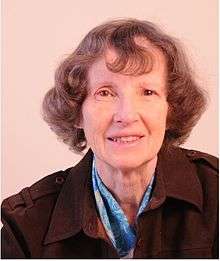Adele Änggård
Adele Änggård (born Adele Hankey, 31 July 1933) is a British-Swedish stage and costume designer whose career has spanned some of the most significant major stages across Europe and Scandinavia. In parallel she's actively pursued archeology and writing, and in later life contributed new interpretations on early European civilizations.
Adele Änggård | |
|---|---|
 | |
| Born | Adele Hankey July 31, 1933 |
| Nationality | Swedish and British |
| Occupation | Stage designer, costume designer |
Notable work | A Humanitarian Past |
| Parent(s) | Robert Hankey, 2nd Baron Hankey |
Background and education
Adele Hankey was daughter of Robert Hankey, 2nd Baron Hankey. From 1948 to 1953 she studied ballet at the Elmhurst Ballet School with a focus on art and design, as well as theatre at the Guildhall School of Music and Drama. From 1960 to 1963 she took a series of design courses under Paul Colin, and studied art at the Académie Julian and with André Lhote at his studio. In 1972 she studied television and film at the College of San Mateo.
Career
Adele Änggård has had a long and prolific career in theatre, contributing to some 80 productions between 1957 and 2000. Her designs were often noted for an essential simplicity, which integrated the visual part of a performance with the drama and acting as a whole.[1]
Prominent opera productions
- Mäster Pedros Marionetter, Drottningholm Palace Theatre (1957) directed by Göran Gentele[2]
- The Bear (1978)
- Il Pastor Fido, National Opera, Oslo (1979)[3]
- Les Mamelles de Tiresias, Oslo (1980)
- Paris and Helena, Drottningholm Palace Theatre (1987)
- La Bohème (1994) directed by Bengt Peterson[4]
- Väntarna/Herkules, Royal Opera, Stockholm (1995)[5]
- Noye's Fludde, Vasa Museum (1995)[6]
Prominent ballet productions
- Coppelia, Royal Swedish Ballet (1958) choreographed by Mary Skeaping
- While the Spider Slept, Royal Swedish Ballet (1966) and Royal Winnipeg Ballet (1967) choreographed by Brian Macdonald
- Kampen om kungakronan, Nyköping, Malmö Stadsteater[7] and SVT[8] (1987) choreographed by Birgit Cullberg
Prominent theatrical productions
- King Lear, Royal Shakespeare Company (assistant designer, 1962) directed by Peter Brook[9]
- Serjeant Musgrave's Dance (1962)
- The Deputy (Le Vicaire) (1963)
- Hamlet (1991) directed by Anita Blom[10]
- Othello (1992)
- Ion (1993)
- Vintergatan (1995) directed by Harald Leander[11]
- The Oresteia, Skillinge teater (1996) directed by Anita Blom
- Don Juan, Skillinge teater (2000) directed by Mario Gonzales
Film production
- King Lear (1971), directed by Peter Brook
Archaeology
In parallel to her theatre career she developed a lifetime interest in ancient Greece and archaeology, starting in childhood with archaeologist Vronwy Hankey, a Minoan and Mycenae specialist and included visits to the caves of Altamira and Lascaux. Later, as an extension of her theatrical career – so as to better understand Greek play scripts – she studied archaeology at Södertörn University, receiving a bachelor's degree.
Following extensive research, she published A Humanitarian Past[12] in 2016. The book adds a sophisticated social dimension to early European history, and challenges modern conceptualizations of the earliest European ancestors as being underdeveloped and prehistoric art as primitive.[13]
Notes
- Nylen, Stina (1998-07-30). "DN gratulerar: På jakt efter essensen". Dagens Nyheter. Retrieved 2016-11-01.
- Burke, P.E. (September 1957). "From P.E. Burke in Stockholm". Music and Musicians. 6 (1).
- Riefling, Reimar (6 September 1979). "Barokk suksess!". VG.
- Edberg, Ulla-Britt (21 February 1994). "De flesta lipar nog när Mimi dör...". Svenska Dagbladet.
- Väntarna / Herkules (Theatrical programme). Stockholm: Royal Opera. 1995.
- Noye's Fludd (Theatrical programme). Stockholm: Vasa museum. 2006.
- Kampen om Kungakronan (Theatrical programme). Malmö: Malmö Stadsteater. 1990.
- "SVT, TV2 1990-12-27". Kungliga biblioteket. Retrieved 1 November 2016.
- King Lear (Theatrical programme). Stratford-upon-Avon: Royal Shakespeare Company. 1962.
- Persson, Anna Lena (5 October 1991). "Gripande mini-Hamlet". Svenska Dagbladet.
- Vintergatan (Theatrical programme). Simrishamn: Grand. 1996.
- Änggård, Adele (2016). A Humanitarian Past: Antiquity's Impact on Present Social Conditions. Milton Keynes: AuthorHouse. ISBN 978-1-4969-9334-2.
- Vanarot, Naud (3 October 2015). "Jämlikheten före de gamla grekerna". Feministiskt Perspektiv. Retrieved 1 November 2016.